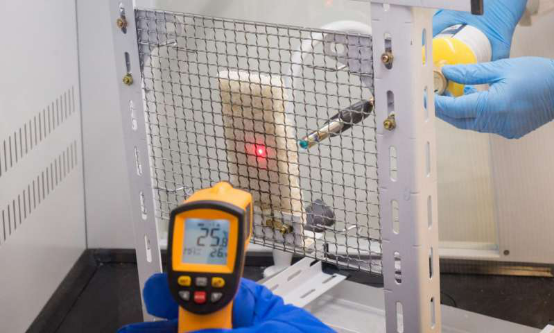
新加坡南洋理工大学已经开发出一种新材料,比起目前市场上使用的绝缘材料,这种新材料能够让车辆和建筑物隔音隔热。
这种被称为气凝胶复合材料的新型泡沫,比传统的绝缘泡沫隔热能力提高2.6倍。
相比传统的隔音材料,它可以阻挡80%的外界噪音,高出普通材料30%。
由二氧化硅气凝胶和一些其它添加剂制成的这种新材料,预计将于明年初投入市场。该产品用途广泛,包括建筑行业、石油和天然气行业以及汽车行业。
气凝胶复合材料是南洋理工大学助理教授Chandrankant Joshi和他的博士生,Mahesh Sachithanadam花费了四年时间开发的。该技术已经发表于同行评议的科学期刊上,并由南洋理工大学的创新和企业部门NTUitive提交了专利申请。
本地公司布朗克斯创意设计中心(Bronx Creative & Design Centre)已获得气凝胶复合材料的经营权。该公司已联合投资的520万美元,产品工厂将于2017年开始生产。
工厂将生产不同类型的气凝胶复合材料,如片或板,与目前工业上应用的尺寸保持一致。
助理教授Sunil说,这种新型泡沫很容易安装和使用,因为它比目前常规泡沫更加薄,还具有更好的性能。
“我们的薄泡沫生产方式也很环保,因为不需要高温处理,在生产过程中也不产生有毒物质。因此它更加环保,对环境影响小,” 南大机械与宇航工程学院助理教授 Sunil说。
布朗克斯创意设计中心的研发总监Thomas Ng说,这种新材料可以解决市场对于高性能隔热隔音材料的真正需求。
“随着全球工业向绿色制造和低碳排放的方向发展,我们生产的新泡沫将有助于解决他们的需要,而且会表现的更好,” Ng先生说。
“我们还要进行研究改良,我们希望在目前的市场上,绿色环保不代表着要在性能上打折扣。我们将于行业伙伴和认证测试实验室一起合作,以确定相关的标准和认证。”
这个新的气凝胶复合材料的商标名称是“Bronx AeroSil”,目前,布朗克斯创意设计中心的首席技术官Mahesh博士正在将其开发成不同的产品。
例如,为了将一辆正在行驶的卡车噪音降低到正常程度,需要15mm厚度的这种新材料。而常规的绝缘泡沫则需要25mm的厚度。
气凝胶复合材料可降低噪音达80 %,而普通泡沫只降低50个百分点,Mahesh博士解释说。
对于隔热能力,Bronx AeroSil比常规泡沫的厚度薄50%,而隔热能力却优于其37%,
“对于隔热隔音的双重作用,现在,我们可以使用更少的材料来达到同样的效果,这也能降低材料的使用量和成本,” Mahesh博士说。
除了是良好的隔音隔热材料,它也是不易燃材料,这对于石油天然气行业高热环境下的应用,是非常关键的因素。
它还具有弹性,可以承受重物。一块10公分宽、10公分长,只有15克重的气凝胶复合材料,可承受高达300公斤重量也不变形。
明年第一季度,布朗克斯创意设计中心将开始为他们的客户大规模生产气凝胶复合材料,包括汽车、电子公司、石油和天然气行业。
技术人员还将继续研究、优化和完善气凝胶复合材料的性能,以保持它对其它技术的竞争优势,Mahesh博士说。(张微/编译)
以下为英文原文:
Team develops thin foam that keeps vehicles and buildings cooler and quieter
Nanyang Technological University, Singapore (NTU Singapore) has developed a new material that will make vehicles and buildings cooler and quieter compared to current insulation materials in the market.
Known as aerogel composites, this new foam insulates against heat 2.6 times better than conventional insulation foam.
When compared to traditional materials used in soundproofing, it can block out 80 per cent of outside noise, 30 per cent more than the usual ones.
Made from silica aerogels with a few other additives, this new material is now ready for commercialisation and is expected to hit the market early next year. The promising product has the potential to be used in a wide range of applications, including in building and construction, oil and gas and the automotive industry.
The aerogel composites took NTU Assoc Prof Sunil Chandrankant Joshi and his then-PhD student, Dr Mahesh Sachithanadam, four years to develop. The technology had been published in peer-reviewed scientific journals and a patent has been filed by NTU''s innovation and enterprise arm NTUitive.
A local company, Bronx Creative & Design Center Pte Ltd (BDC), has licensed this aerogel composites technology with a joint venture of S$7 million (USD$5.2 million), and a production plant that will be operational by 2017.
It will produce the aerogel composites in various forms such as sheets or panels, in line with current industry sizes.
Assoc Prof Sunil said the foam will be easy to install and use as it is thinner than conventional foam yet has better performance.
"Our NTU thin foam is also greener to manufacture, as it does not require high heat treatment or toxic materials in its production. It is therefore a lot more eco-friendly and less hazardous to the environment," explained Prof Sunil who is from NTU''s School of Mechanical and Aerospace Engineering.
Mr Thomas Ng, R&D Director of BDC, said this new material could address a real market need for high-performance heat insulation and better sound proofing.
"With the global industries moving towards green manufacturing and a lowered carbon footprint, the new foam we produce will help address their needs and yet give a better performance," Mr Ng said.
"Moving forward, we hope to show the current market that going green doesn''t mean that performance has to be compromised. We will be working with industry partners and certified testing labs to achieve the relevant standards and certifications.
The new aerogel composite has been branded "Bronx AeroSil" by BDC and is being developed for various applications by Dr Mahesh, now the Chief Technology Officer at BDC.
For example, to reduce the noise generated by a truck driving by to that of a normal conversation, only 15mm of the new material would be needed. On the other hand, common insulation foam requires a thickness of 25mm.
The aerogel composite can reduce noise by as much as 80 per cent whereas normal foam only reduces sound by 50 per cent, explained Dr Mahesh.
Against heat, Bronx AeroSil which is 50 per cent thinner than conventional foam will still out-perform it by 37 per cent.
"For both heat insulation and sound-proofing, we can now use less material to achieve the same effect, which will also lower the overall material and logistic costs," Dr Mahesh said.
Apart from being a good thermal and acoustic insulator, it is also non-flammable - a crucial factor for materials used in high heat environments common in the oil and gas industries.
It is also resilient and can withstand high compression or heavy loads. A small 10cm by 10cm piece of the aerogel composite material weighing just 15 grams can take up to 300 kilogrammes of weight, maintaining its shape without being flattened.
In the first quarter of next year, BDC will begin mass producing the aerogel composites for their clients, which include companies from the automotive, electronics, and oil and gas sectors.
Further research and optimisation would be carried out to improve the performance of the aerogel composite material to ensure it maintains its competitiveness edge against other technologies, said Dr Mahesh.
- 江南大学付少海/王冬团队 Small:原位矿化生成的双网络结构壳聚糖复合气凝胶用于替代石油基保温材料 2025-10-27
- 东华大学朱美芳/成艳华团队 Nat. Commun.:3D打印高透明高隔热气凝胶 2025-09-05
- 西工大李炫华教授、冯蕊副教授 AM:太阳能-机械共生双模式气凝胶实现多场景适应大气水收集 2025-09-02
- 青科大张建明、陈玉伟 ACHM:提出离子液体助推BN电场取向的新策略 - 实现硅橡胶复合材料导热性能提升 2025-12-15
- 四川大学傅强/吴凯团队 Nat. Commun.:BCC最小热阻路径模型用于高填充复合材料热传导的逾渗与预测 2025-12-08
- 甬江实验室方磊教授团队 AFM:无溶剂介导的热塑性聚氨酯复合材料-具有稳定、可逆的热荧光响应 2025-12-05
- 北科大杜鑫、张美芹教授 ACS Nano:单胶束受限组装构建具有可控多尺寸孔和不对称蛋黄@壳结构的聚多巴胺@二氧化硅纳米复合粒子 2024-10-01
